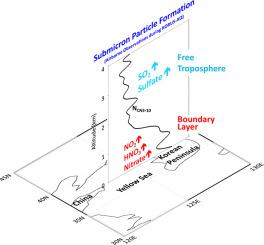Atmospheric Research ( IF 5.5 ) Pub Date : 2021-09-16 , DOI: 10.1016/j.atmosres.2021.105857 Do-Hyeon Park 1 , Chaeyoon Cho 1 , Hyeonmin Kim 1 , Rokjin J Park 1 , Bruce Anderson 2 , Taehyoung Lee 3 , Greg L Huey 4 , Paul O Wennberg 5 , Andrew J Weinheimer 6 , Seong Soo Yum 7 , Russell Long 8 , Sang-Woo Kim 1

|
In this study, we contrasted major secondary inorganic species and processes responsible for submicron particle formation (SPF) events in the boundary layer (BL) and free troposphere (FT) over the Korean Peninsula during Korea-United States Air Quality (KORUS-AQ) campaign (May–June 2016) using aircraft observations. The number concentration of ultrafine particles with diameters between 3 nm and 10 nm (NCN3–10) during the entire KORUS-AQ period reached a peak (7606 ± 12,003 cm−3) at below 1 km altitude, implying that the particle formation around the Korean Peninsula primarily occurred in the daytime BL. During the BL SPF case (7 May 2016), the SPF over Seoul metropolitan area was more attributable to oxidation of NO2 rather than SO2-to-sulfate conversion. From the analysis of the relationship between nitrogen oxidation ratio (NOR) and temperature or relative humidity (RH), NOR showed a positive correlation only with temperature. This suggests that homogeneous gas-phase reactions of NO2 with OH or O3 contributed to nitrate formation. From the relationship between NCN3–10 (> 10,000 cm−3) and the NOR (or sulfur oxidation ratio) at Olympic Park in Seoul during the entire KORUS-AQ period, it was regarded that the relative importance of nitrogen oxidation was grown as the NCN3–10 increased. During the FT SPF case (31 May 2016) over the yellow sea, the SO2-to-sulfate conversion seemed to influence SPF highly. The sulfate/CO ratio had a positive correlation with both the temperature and RH, suggesting that aqueous-phase pathways as well as gas-phase reactions might be attributable to sulfate formation in the FT. In particular, FT SPF event on 31 May was possibly caused by the direct transport of SO2 precursors from the continent above the shallow marine boundary layer under favorable conditions for FT SPF events, such as decreased aerosol surface area and increased solar radiation.
中文翻译:

边界层与自由对流层亚微米粒子的形成:来自 NASA DC-8 在 KORUS-AQ 活动期间对亚洲大陆外流观测的案例研究
在这项研究中,我们对比了韩美空气质量 (KORUS-AQ) 期间朝鲜半岛边界层 (BL) 和自由对流层 (FT) 中亚微米粒子形成 (SPF) 事件的主要次生无机物种和过程活动(2016 年 5 月至 6 月)使用飞机观测。在整个 KORUS-AQ 期间,直径在 3 nm 和 10 nm 之间的超细粒子(N CN3 – 10 )的数量浓度在 1 km 高度以下达到峰值(7606 ± 12,003 cm -3),这意味着周围的粒子形成朝鲜半岛主要发生在白天的BL。在 BL SPF 案例(2016 年 5 月 7 日)期间,首尔市区的 SPF 更多归因于 NO 2的氧化而不是 SO2-到硫酸盐的转化。从氮氧化率(NOR)与温度或相对湿度(RH)的关系分析可知,NOR仅与温度呈正相关。这表明 NO 2与 OH 或 O 3的均相气相反应有助于硝酸盐的形成。从整个 KORUS-AQ 期间首尔奥林匹克公园 N CN3 – 10(> 10,000 cm -3)与 NOR(或硫氧化率)之间的关系来看,氮氧化的相对重要性被认为是增长的N CN3-10增加。_ 在黄海上空的 FT SPF 案(2016 年 5 月 31 日)期间,SO 2- 到硫酸盐的转化似乎对 SPF 影响很大。硫酸盐/CO 比率与温度和 RH 均呈正相关,表明水相途径和气相反应可能归因于 FT 中的硫酸盐形成。特别地,5月31日的FT SPF事件可能是由于SO 2前体在有利于FT SPF事件的条件下从浅海边界层上方的大陆直接传输引起的,例如气溶胶表面积减少和太阳辐射增加。



























 京公网安备 11010802027423号
京公网安备 11010802027423号